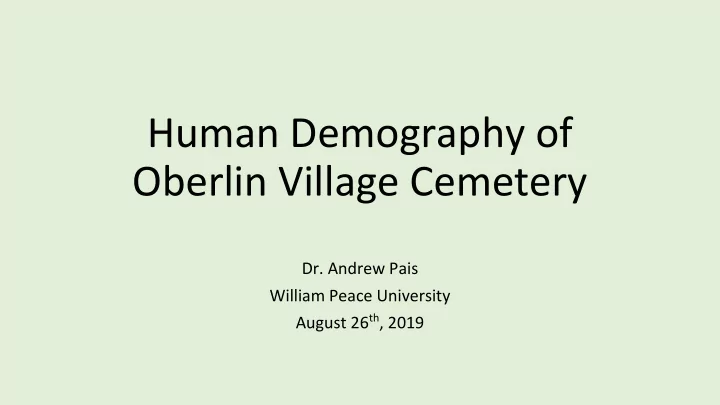

Human Demography of Oberlin Village Cemetery Dr. Andrew Pais William Peace University August 26 th , 2019
What does an ecologist do? Studies interactions between organisms and their environment.
What is demography? The study of the structure and growth of populations
Life table
Survivorship Varies among Human Populations Survivorship curve: the probability that someone will be alive at a given age
Why study cemeteries? • Course-based Undergraduate Research Experience: • How to create and interpret life tables • Examine patterns of life and death in humans • Connect students with local communities and their history
Why study cemeteries? Cohort studies • Course-based Undergraduate Research Experience: • How to create and interpret life tables • Examine patterns of life and death in humans • Connect students with local communities and their history
Why study cemeteries? Static studies • Course-based Undergraduate Research Experience: • How to create and interpret life tables • Examine patterns of life and death in humans • Connect students with local communities and their history Linda Wade B- July 1, 1825 D- June 20, 1875
Why study cemeteries? • Course-based Undergraduate Research Experience: • How to create and interpret life tables • Examine patterns of life and death in humans • Connect students with local communities and their history
Question: How do patterns of human survival in Raleigh area vary among ages, sex, time period, and community?
Student Hypotheses • Modern human populations live longer on average than historic populations • Females live longer than men • Different communities will show different patterns
• Male or Female • Note age at death • Note time period of death: • Pre 1910 • 1910-1950 • Post 1950 • Skip ambiguous tombstones Methods
Results
Clear differences in populations from different time periods
Expected differences between males and females less apparent in modern (post-1950s) era
While survivorship patterns lower overall for Oberlin Community pre-1910 …
Disparity is nearly reversed in Oberlin population dying post 1950
Conclusions • Clear differences in populations from different time periods • Expected differences between males and females less apparent in modern (post-1950s) era • While survivorship patterns lower overall for Oberlin Community pre-1910 , disparity is nearly reversed in Oberlin population dying post 1950
Biases, limitations, and other disclaimers • Infant graves are likely underrepresented • Differences in maintenance of cemeteries • Patterns noted from comparison of three cemeteries should not be generalized to our understanding of socioeconomic trends at national, state, or regional level • Underlying causes of observed patterns are speculative
Acknowledgements • NC State • Dr. Tom Wentworth • Dr. Nick Haddad • 2013-2016 Ecology Labs • William Peace University • Dept. of Science and Mathematics • Dr. Vincent Melomo • 2018 Fall Ecology Lab • Student Project • Savannah Jackson • Tiaja Arnold • Friend of Oberlin Village • Cheryl Williams • Sabrina Goode • All of you who came to listen today!
Future ecology projects at cemetery
Recommend
More recommend